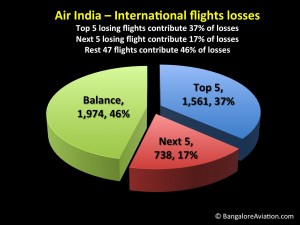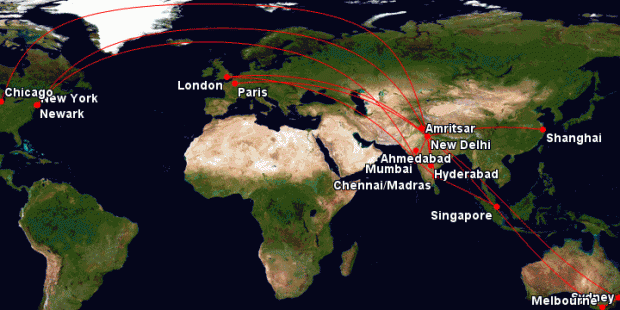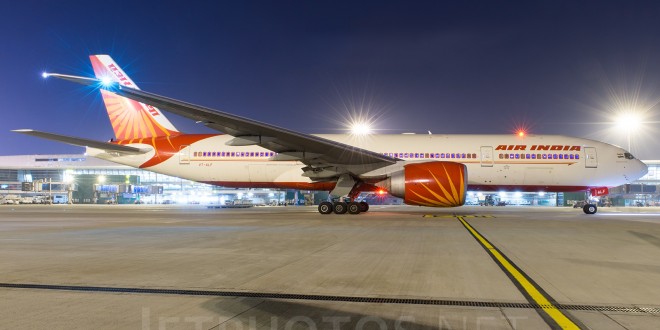National carrier Air India lost money on 57 of its 59 international routes in the last fiscal year which ended March 31, 2014. The airline lost a whopping Rs 4,273.35 crores (approximately $712 million at current exchange rates) operating these international flights. This according to an internal “Route Economics” provisional report for April 1, 2013 to March 31, 2014 which Bangalore Aviation reviewed.
Over half of the 59 international flights, 32 or 55%, did not even earn their direct out-of-pocket cash operating costs. Tantamount to taking tax-payer bailout money and setting it on fire, the airline failed to generate enough revenue from these flights to cover even its basic cash operating expenses by Rs 575 crore ($96 million), forget the payback on the massive Rs 40,000 crore debt the airline is sitting on or the other overheads such as management expenses, ground and station staff expenses, etc.
In a direct contrast to India’s leading private airline Jet Airways, whose international division earns profit which is lost by domestic operations, Air India’s international operations contribute to over 80% of its total annual loses.
We wrote to the airline a week ago with a list of questions. Till date it has not responded.
Break even, cash costs and total costs
As per sources, Air India defines cash costs as out-of-pocket expenses incurred in operating a flight; fuel, crew costs, ground handling, airport charges, en-route navigation, crew hotel, etc. The total costs include the overheads of the airline including cost of aircraft.
As per an analyst at an international aviation consulting firm, who cannot be named since he is not authorised to speak to the media, the norms for break even on international routes is a maximum within two years and to make the route profitable within three. Most airlines pull the route if they do not meet these benchmarks. Low cost carriers like AirAsia are even more aggressive. When we asked about cash costs the analyst said “The concept of cash-cost is unique to Air India. No global airline follows it. All airlines look at total costs.” He went on to suggest Air India is using the benchmarks of “ATF cost” and “cash/variable cost” to deflect from its real under-performance vs. total costs.
Eliminating just three flights will save Rs 1,080 crore
The top three loss making flights are to the United States. Two of these three are from Prime Minister Modi’s home airport of Ahmedabad, though these flights were operating long before he became the Prime Minister.

The Ahmedabad Mumbai Newark return AI144/AI191 route lost a staggering Rs 470 crore ($78.3 million) last year despite having a passenger load factor of 74%, normally considered a break-even load factor. This translates to a loss of about Rs 25,000* 7,297.39 per passenger the airline transported on the route over the year. This one flight alone, accounts for 11% of Air India’s international flight losses.
* We made a calculation error for which we apologise. The new figure is calculated using the revenue passenger kilometres figures from the report and the route length for a very accurate calculation.
The Mumbai New Delhi New York return AI101/AI102 flights lost Rs 370 crores with a load factor of 72%, again considered good. This flight contributes about 8.7% of the airline’s losses.
The Ahmedabad Mumbai London Heathrow return AI131/AI130 route lost Rs 260 crore ($43.3 million) with a load factor of 69%.
Just eliminating these three flights will save Rs 1,080 crore, more than a quarter (25.27%) of Air India’s international flight losses. The top five “loss leaders” flights contribute Rs 1,561 crore or 36.5% of the losses. The top ten contribute Rs 2,299 crore or over half (54%) of the losses.
Analysis
Not even meeting fuel costs
Even the much vaunted New Delhi Sydney Melbourne return AI301/AI302 flights operated by the fuel efficient Boeing 787-8 Dreamliner lost about Rs 77 crores in about nine months of operation with half the losses (Rs 34.5 crore) coming in the month of March 2014 alone. Alarmingly, in the month the Australia flights did not even generate enough revenue to pay for the fuel burnt on the trips. Rs 22 crore earned vs. Rs 26 crore spent on fuel.
The two profitable flights?
AI251/AI252 between Varanasi and Kathmandu and AI227/AI228 between Kolkata and Yangon (Rangoon). And in case you are wondering, these two flights have a passenger load factor averaging a lowly 43% which shows yield (amount earned per passenger) is equally a key to profitability as passenger load factor. High yields and high load factors lead to high profits. Readers will observe the government hierarchy always quotes increase in load factors but never focuses on yields. Air India’s formula is simple. Drop prices, fill seats.
Air India’s Top 10 losing flights
The map (generated with GCMap) shows the top 10 loss making routes of Air India, while the table below shows the losses.
Map

Map courtesy GCMap.com.
Table – Air India’s top 10 wall of shame
| Sl. No. | Flight Pair | Route | Total Revenue | PLF % | Profit or Loss (Rs cr.) | |
| On Cash Cost | On Total Cost | |||||
| 1 | 144/191 | Ahmedabad Mumbai Newark & vv | 710 | 74.37% | -110 | -470 |
| 2 | 101/102 | Mumbai Delhi New York & vv | 895 | 72.10% | 27 | -350 |
| 3 | 131/130 | Ahmedabad Mumbai London & vv ^ | 433 | 69.49% | -47 | -260 |
| 4 | 127/126 | Hyderabad Delhi Chicago & vv | 1,003 | 78.76% | 136 | -254 |
| 5 | 111/112 | Amritsar Delhi London & vv | 460 | 78.21% | -18 | -226 |
| Sub-total |
-1,561 |
|||||
| 6 | 301/302 | Delhi Sydney Melbourne Delhi ^ | 218 | 71.58% | -77 | -183 |
| 7 | 115/116 | Amritsar Delhi London & vv ^ | 308 | 72.02% | -19 | -154 |
| 8 | 142/143 | Chennai Delhi Paris & vv ^ | 400 | 72.51% | 18 | -142 |
| 9 | 342/343 | Mumbai Chennai Singapore & vv | 165 | 70.05% | -17 | -136 |
| 10 | 348/349 | Mumbai Delhi Shanghai & vv ^ | 180 | 59.68% | -29 | -123 |
| Sub-total | -738 | |||||
| ^ Boeing 787 flights | Total | -2,299 | ||||
The EBITDA deflection
Unlike the private airlines who lease their aircraft and show the lease costs as a part of the EBITDA (earnings before interest taxation depreciation and amortisation), Air India has bought bulk of its fleet with a 97% debt component. Therefore the airline pays heavy interest and amortised principal costs of loans along with depreciation of the asset in their books. The airline’s recent presentation of EBITDA figures which does not factor in these three major payments of interest, depreciation and amortisation, does not seem to present an accurate view of the situation and have raised eyebrows.
Share your thoughts
This time, a little more than usual we request your comments on this situation at Air India.
 Bangalore Aviation News, Reviews, Analysis and opinions of Indian Aviation
Bangalore Aviation News, Reviews, Analysis and opinions of Indian Aviation





What about domestic? 🙂
Data was probably not available. Anyone with data – pass it on for an equally in-depth analysis!
Have the data. Have not had the time. 🙂 {blush}
Working on it. Sorry have been very busy with work this week, and the “Pithra-paksha” annual ceremonies.
Mind boggling!! I guess unlimited and unconditional government subsidies removes any urgency for an in depth review of their route structure, revenues and costs. Assuming AI tickets are on par with the industry, they definitely need to review their cost structure.
But then, I suppose I am restating the obvious…. must be great working for AI.
This screams three things
1 – Drop the domestic widebody tags. That alone must be costly in terms of fuel and maintenance and be a nightmare for operations.
2 – The 787 is not the panacea it was supposed to be – their renewed global expansion will come at a major cost
3 – Its time for Air India to cut their North American operation, or perhaps dust down their old plans for a scissor hub in Dublin or Birmingham. Hopefully with lower competition to London with VS dropping out, loads and yield will improve. I would love to see how BHX is performing.
Lets hope that Star Alliance brings extra yield.
Domestic widebody tags – absolutely – should be dropped ASAP. The 787 can bring ~20% lower fuel costs compared to a 767, but it’s possible the larger 77W might have similar costs per seat – given it’s supposed to have legendary efficiency. Of course AI’s problem is that the F/J seats are not filled with high-yielding pax.
I don’t think a hub in DUB or BHX is going to help AI – not with their current high cost base.
Birmingham; Air India had the figures and the stats that it would be a horrifically low yielding route but stubbornly believed it would deliver. You can fill a Dreamliner, but when people pay below costs, the dream becomes a problem nightmare.
Time has come for AI privatization?? Poor management, improper use of aircraft, poor network and connections, lazy and ‘I don’t care employees’, poor public image and most of all too much involvement of our beloved political babus…AI should be removed from the hands of govt. Indian govt has sinked this wonderful brand into the deep ocean.
The big 3 MEA have taken away majority of the traffic away from AMD. To be blamed with the poor experience of having to go through changing planes at Mumbai (endless hours waiting in the middle of the night with children and elders along) to catch their onwards flights also result into frustrated customers. Surprisingly the high load factors are a stark contrast to what I said but it would be good to know what is contributing to such high load factors from AMD. I would definitely prefer a direct (non-stop) flight from AMD rather than change planes. It can be good to see if the other combination of a BOM-AMD-XXX works. But then who knows, would be worth a trial. These are my 2 cents and would be happy to be challenged. 🙂
Stunning, isn’t it.
As Air India is a national airline,so cant it focus on international routes originating apart from BOM/DEL.There are international routes which can be operated from other cities like BLR/HYD/MAA.
Air India will/can only focus where the elite “elected” few dictate tell them to. For too long, the airline has been shackled by bureaucracy, free loading and blame culture. No-one will be brought in to sort it out because those responsible for Air India’s future are happy with how it currently is and are too happy to blame Boeing, passing sea birds and anyone else. For a nation so vast and populous, that a national carrier can not profit and, dare I say, THRIVE, it is veritably criminal. Heads should roll.
Air India…. needs to shrink on Int and focus on neighbouring and east, alongside maintain fewer self operating flights to Us and Europe… give star alliance an opportunity to grow and expand connections while Air India goes for a complete take over in 5 years from now… it’s bound to happen.
Political meddling creates a terrible network.
AI really should have three hubs servicing the bulk of international flights (save some Middle East and Southeast Asia): DEL, BOM, BLR
DEL: Europe and North America. This would be the hub to service BHX, MAN, JFK/EWR/ YYZ, YVR, ORD, etc.
BOM: Europe and Africa. Aside from LHR, CDG, you add Mauritius, South Africa, etc.
BLR: Some Europe, but focus on Southeast Asia and Australia. LHR, FRA, BER (techie hub), and SIN, SYD, MEL, etc.
It doesn’t make sense to run DEL-SYD-MEL. They shouldn’t be running that triangular ultra-long haul service. They should be running dailies to SYD and MEL, and in time PER and BNE, from BLR. And then short-haul all over India. And some transfer traffic to European flights.
And no domestic tags. Cities like AMD would actually benefit from regular short-haul to hubs. They’d get way more flights from BOM, DEL and BLR.
It’s crazy how inefficient the setup is.